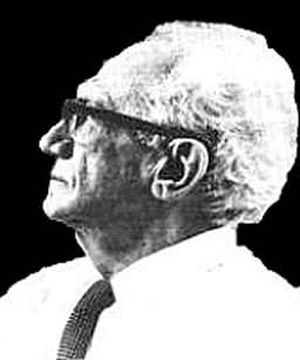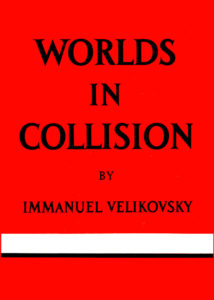Peer review (or refereeing) is a part of the scientific process, in which an author’s work is submitted to experts (ie. peers) for evaluation, to determine suitability for publication. Immanuel Velikovsky has been criticized for not submitting his work for peer review; His book, Worlds in Collision, was refereed.
Criticisms of no peer review
Velikovsky not refereed?
Brian Martin notes:
“.. it is useful to re-evaluate the reasons for the scientific community’s violent attack on Immanuel Velikovsky and his ideas. It is difficult to see this attack as motivated by Velikovsky’s transgression of the norms of science. For example, it may be said that he violated the norm of disinterestedness by publishing his work for profit before getting it refereed by scientists (Blissett, 1972)[1]Blissett, M. (1972): Politics in Science. Boston, Little, Brown. .. Velikovsky’s manuscript was refereed by several people (for details, see de Grazia, 1966)[2]de Grazia, A. (ed.) (1966): The Velikovsky Affair. London, Sidgwick and Jackson. .”[3]Brian Martin, “The Determinants of Scientific Behaviour“, SIS Review Vol II No 4 (Spring 1978). Online at Professor Brian Martin’s Web site at the University of Wollongong
Velikovsky rejects peer review?
Michael Shermer et al claimed that Velikovsky:
“.. was always free to submit papers to technical journals, but he chose not to do so, because he rejected on principle the practice of peer review”.[4]Michael Shermer, Pat Linse, The Skeptic Encyclopedia of Pseudoscience, Published by ABC-CLIO, 2002, ISBN 1576076539, 902 pages. (Page 476)
Carl Sagan on peer review
In Scientists Confront Velikovsky (1974), the proceedings of the 1974 AAAS meeting “Velikovsky’s Challenge to Science“, Carl Sagan‘s introduction to his paper “Movements of Celestial Bodies-Velikovsky’s Fatal Flaw” noted:
“For example, here is a summary, of a type which is unusual but not extremely rare, of a paper submitted to the scientific journal Icarus, by a qualified referee: “It is the opinion of this reviewer that this paper is absolutely unacceptable for publication in Icarus. It is based on no sound scientific research, and at best it is incompetent speculation. The author has not stated his assumptions; the conclusions are unclear, ambiguous and without basis; credit is not given to related work; the figures and tables are unclearly labled; and the author is obviously unfamiliar with the most basic scientific literature….” The referee then goes on to justify his remarks in detail. The paper was rejected for publication. Such rejections are commonly recognized as a boon to science as well as a favor to the author. Most scientists are accustomed to receiving (somewhat milder) referees’ criticisms every time they submit a paper to a scientific journal. Almost always the criticisms are helpful.”[5]Carl Sagan, “Movements of Celestial Bodies-Velikovsky’s Fatal Flaw”, in Donald W. Goldsmith (Editor), Scientists Confront Velikovsky (1977), Cornell University Press, ISBN 0801409616, ISBN-13 978-0801409615. Contents at the SAO/NASA Astrophysics Data System (ADS)
Norman Storer on peer review
Also in the AAAS proceedings, Norman Storer notes:
“Finally, because he sought vindication from the lay public through the popular press, rather than through communication with scientists in the archival literature, he was criticized for failing to play the game properly-even though access to the scientific journals through regular channels was probably not open to him.”[6]Norman Storer, “An Analysis of Worlds in Collision“, in Donald W. Goldsmith (Editor), Scientists Confront Velikovsky (1977), Cornell University Press, ISBN 0801409616, ISBN-13 978-0801409615. Contents at the SAO/NASA Astrophysics Data System (ADS)
In Stephen J. Gould and Immanuel Velikovsky (1996), Charles Ginenthal comments:
“This, then, is the double bind in which Velikovsky found himself. Storer states that Velikovsky, to play the game of science properly, should have published his work in peer reviewed scientific journals. Since he didn’t follow this route, he was not following the norms of science. But Storer knew full well, and admits as much, that these channels of access to the scientists were “not open to him.” The double bind is rejecting Velikovsky’s ideas based on the norm of publishing in the acceptable scientific journals while knowing he could not do so! Because this door of expression was closed to Velikovsky, he published his concepts in book form. Storer’s norm for Velikovsky was that he either publish in the journals that would never accept his material for publication, or that he never publish at all!”[7]Charles Ginenthal, The AAAS Symposium on Velikovsky in Stephen Jay Gould and Immanuel Velikovsky (1996)
Alan Cromer on peer review
“Every article must be approved by several peer reviewers. These reviewers are researchers themselves, whose own research passes through the same process. The main purpose of the review is to check whether the paper is up to the current standards of the field. Is the author aware of the latest ideas and methods? Are there any obvious mistakes in logic or methodology? Are other related works properly referenced? Does the paper really have anythingnew to say? In short, is the paper capable of affecting the consensus in the field?
“.. The situation was quite different in the case of Immanuel Velikovsky. .. This wasn’t censorship in any useful meaning of the word; it was an attempt to prevent a blatantly unscientific work from being published with the scientific imprimatur that the Macmillan name carried. .. What he couldn’t do was get an article published by a scientific journal.” [8]Alan Cromer, Uncommon Sense: The Heretical Nature of Science, Oxford University Press, USA (January 1, 1993), ISBN-10: 0195096363. pp.148-151 At Amazon.com
Peer reviewed
Worlds in Collision peer reviewed
Worlds in Collision was refereed by:
- John J. O’Neill, science editor of the New York Herald Tribune
- Gordon Atwater of the Hayden Planetarium and the American Museum of Natural History
- C. W. van der Merwe (Carel Willem van der Merwe, 1890-1990), professor of physics at New York University
- Clarence S. Sherman, associate professor of chemistry at Cooper Union College
- E. M. Thorndike, head of the physics department at Queens College
Henry Bauer notes that:
“Macmillan had followed the normal procedure of having the manuscript of Worlds in Collision evaluated by outside readers. We know the identities of two of them: O’Neill, science editor of the New York Herald Tribune, and Atwater of the Hayden Planetarium and the American Museum of Natural History. .. when Shapley protested before Worlds in Collision was actually published, Macmillan sought reviews from three new and impartial referees. ..
“The reviewers’ letters, now available in the Macmillan files at the New York Public Library, reveal that none of the three actually recommended against publication. In addition to C. W. van der Merwe, professor of physics at New York University, the readers were Clarence S. Sherman, associate professor of chemistry at Cooper Union College, and E. M. Thorndike, head of the physics department at Queens College. Though there are no statements against publication of the book, two of the three letters contain strong criticisms on some points of science. (The Macmillan files also reveal that similarly strong criticisms on points of science had been made by O’Neill, who was one of the first readers of the manuscript originally submitted by Velikovsky to Macmillan.)”[9]Henry H. Bauer, “Means of Persuasion”, Beyond Velikovsky[10]Letter, “Dr. E. M. Thorndike to The Macmillan Company“, Feb. 13, 1950. Online at the Velikovsky Archive.[11]Letter, “C. W. van der Merwe to H. B. McCurdy, The MacMillan Company“, February 14, 1950. Online at the Velikovsky Archive[12]Letter, “Clarence S. Sherman to Henry B. McCurdy, The Macmillan Company“, February 14, 1950. Online at the Velikovsky Archive.
Velikovsky on peer review
In his book, Stargazers and Gravediggers, Velikovsky commented on Kirtley Mather, geologist of Harvard:
“According to Mather, I had failed to submit my theory to the scrutiny of my “peers.” As the reader knows by now, I was eager to have the criticism of astronomers and physicists, although my work was built mainly on literary and folkloristic material. Curiously, the charge of evading the scientists came from the same Harvard group that had refused to read the manuscript from the spring of 1946 on, when I asked Shapley, orally and in writing, to read it. The truth is that every statement in the book relating to matters of science was checked and rechecked with scientists in various fields. And the publisher submitted the manuscript to a board of review and to a “jury” and to “censors,” including the head of the Department of Physics at New York University, and it passed all these reviews only to be attacked by scientists who neglected the first rule of inquiry: Read what you discuss; know what you reject.”[13]Immanuel Velikovsky, Stargazers and Gravediggers, 1983 William Morrow and Company, ISBN 0-688-01545-X
References
| ↑1 | Blissett, M. (1972): Politics in Science. Boston, Little, Brown |
|---|---|
| ↑2 | de Grazia, A. (ed.) (1966): The Velikovsky Affair. London, Sidgwick and Jackson. |
| ↑3 | Brian Martin, “The Determinants of Scientific Behaviour“, SIS Review Vol II No 4 (Spring 1978). Online at Professor Brian Martin’s Web site at the University of Wollongong |
| ↑4 | Michael Shermer, Pat Linse, The Skeptic Encyclopedia of Pseudoscience, Published by ABC-CLIO, 2002, ISBN 1576076539, 902 pages. (Page 476) |
| ↑5 | Carl Sagan, “Movements of Celestial Bodies-Velikovsky’s Fatal Flaw”, in Donald W. Goldsmith (Editor), Scientists Confront Velikovsky (1977), Cornell University Press, ISBN 0801409616, ISBN-13 978-0801409615. Contents at the SAO/NASA Astrophysics Data System (ADS) |
| ↑6 | Norman Storer, “An Analysis of Worlds in Collision“, in Donald W. Goldsmith (Editor), Scientists Confront Velikovsky (1977), Cornell University Press, ISBN 0801409616, ISBN-13 978-0801409615. Contents at the SAO/NASA Astrophysics Data System (ADS) |
| ↑7 | Charles Ginenthal, The AAAS Symposium on Velikovsky in Stephen Jay Gould and Immanuel Velikovsky (1996) |
| ↑8 | Alan Cromer, Uncommon Sense: The Heretical Nature of Science, Oxford University Press, USA (January 1, 1993), ISBN-10: 0195096363. pp.148-151 At Amazon.com |
| ↑9 | Henry H. Bauer, “Means of Persuasion”, Beyond Velikovsky |
| ↑10 | Letter, “Dr. E. M. Thorndike to The Macmillan Company“, Feb. 13, 1950. Online at the Velikovsky Archive. |
| ↑11 | Letter, “C. W. van der Merwe to H. B. McCurdy, The MacMillan Company“, February 14, 1950. Online at the Velikovsky Archive |
| ↑12 | Letter, “Clarence S. Sherman to Henry B. McCurdy, The Macmillan Company“, February 14, 1950. Online at the Velikovsky Archive. |
| ↑13 | Immanuel Velikovsky, Stargazers and Gravediggers, 1983 William Morrow and Company, ISBN 0-688-01545-X |

